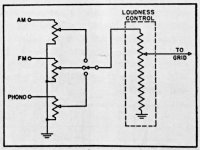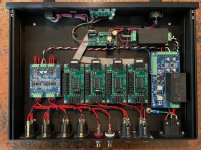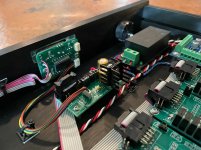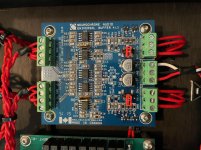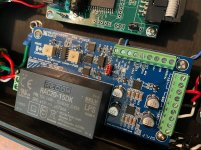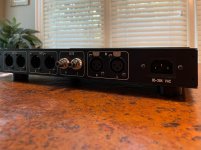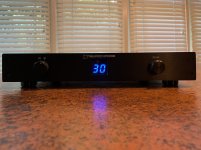@Vunce : Thanks for the compliment 
I've just ordered a second Universal Buffer to add as a BAL/UNBAL conversion.
@Tom
Do you think that attaching all grounds (input/output) with a single 14Ga copper wire and connecting to the PCB ground would be a better option to prevent any ground loop or ground buzz?
Thanks
Do
I've just ordered a second Universal Buffer to add as a BAL/UNBAL conversion.
@Tom
Do you think that attaching all grounds (input/output) with a single 14Ga copper wire and connecting to the PCB ground would be a better option to prevent any ground loop or ground buzz?
Thanks
Do
Tom, what's the absolute max psu rail +/-, I'm figuring on building one into a Paradise phonostage as a change to a pair of Calvin buffers.
Hi!
I believe it is +/- 17VDC (and likely +/- 18VDC given that Tom is conservative). He also publishes what the maximum voltage swing is at various psu rail voltages along with distortion levels at those voltages. Just click on 'Specifications' and 'Performance Graphs' on this link.
For example at +/- 17VDC, the maximum voltage swing prior to the onset of clipping (and at the lowest distortion level) is 23dBu or thereabouts. That's equivalent to 10.95Vrms or ~31Vpp.
Best,
Anand.
Last edited:
Tom, what's the absolute max psu rail +/-, I'm figuring on building one into a Paradise phonostage as a change to a pair of Calvin buffers.
Sorry. Your question drowned in other posts. ±17 V is the maximum recommended design target. ±18 V is ABS MAX for the ICs involved.
Personally I'd use ±12 - ±15 V.
Tom
upgrade?Tom, what's the absolute max psu rail +/-, I'm figuring on building one into a Paradise phonostage as a change to a pair of Calvin buffers.
Hi Tom,
Earlier in the thread you mentioned that when using potentiometers with this buffer, lower value was better. Someone asked about using a stepped attenuator vs a pot and I think you missed it because I didn’t see your answer to the question. I’m curious because Goldpoint offers 24 position attenuators with unstuffed PCBs to allow custom values (see here). According to the table at the link, a 5K attenuator is possible, as are even lower values.
I was interested in your thoughts as I would like to use a balanced stepped attenuator with your buffers. See attached block diagram for reference.
Earlier in the thread you mentioned that when using potentiometers with this buffer, lower value was better. Someone asked about using a stepped attenuator vs a pot and I think you missed it because I didn’t see your answer to the question. I’m curious because Goldpoint offers 24 position attenuators with unstuffed PCBs to allow custom values (see here). According to the table at the link, a 5K attenuator is possible, as are even lower values.
I was interested in your thoughts as I would like to use a balanced stepped attenuator with your buffers. See attached block diagram for reference.
Attachments
A stepped attenuator will have just as much Johnson noise / thermal noise as a potentiometer. A 10 kΩ attenuator will have the same noise performance as a 10 kΩ pot.
Lower is better for thermal noice. After all, en = 4*k*T*R, where R is the resistance. But lower resistance of the pot/attenuator also means greater load on the source, which brings higher distortion. So that's the tradeoff.
Tom
Lower is better for thermal noice. After all, en = 4*k*T*R, where R is the resistance. But lower resistance of the pot/attenuator also means greater load on the source, which brings higher distortion. So that's the tradeoff.
Tom
Depends. If the source is a modern opamp such as the LME49720/LM4562 or OPA1612, OPA1656, etc. you could go even lower. Maybe even as low as 600 Ω, but you're not likely to find a commercially available attenuator with that low resistance. 5 kΩ is available on special order from Alps (MOQ 500). So most likely you'll have to settle for 10 kΩ, but if you can find 5 kΩ and have a modern source, use it.
If you're using a tube amp to drive the attenuator, you'll probably want 10-20 kΩ minimum.
If you do find a low-resistance attenuator, watch the power dissipation.
Tom
If you're using a tube amp to drive the attenuator, you'll probably want 10-20 kΩ minimum.
If you do find a low-resistance attenuator, watch the power dissipation.
Tom
A 10k pot has a maximum Johnson noise resistance at half way, so 2 x 5k in parallel. So a maximum noise resistance of 2.5k - which is 6.4nV/rootHz or about 1uV in a 20kHz bandwidth. That is -120dBV, which is very quiet. Also remember that this is the worst case, when the pot is set to only 6dB attenuation.
If the (log) pot is set to -20dB, which is typical, the noise resistance is 900 ohms, or -125dB.
You'd be pushed to hear either.
Now you can get lower resistance log pots, but they are cermet rather than the much higher performance conductive plastic.
If you want a lower resistance the best way to go is a switch and construct your own attenuator using metal film resistors (either discrete or surface mount).
Or buy one from Khozmo High Quality Audio & Industrial Attenuators and Passive Preamplifiers who do standard attenuator values of 600R, 1K, 2K, 5K, 10K, 20K, 50K, 100K, 250 kohm, or custom values
Craig
If the (log) pot is set to -20dB, which is typical, the noise resistance is 900 ohms, or -125dB.
You'd be pushed to hear either.
Now you can get lower resistance log pots, but they are cermet rather than the much higher performance conductive plastic.
If you want a lower resistance the best way to go is a switch and construct your own attenuator using metal film resistors (either discrete or surface mount).
Or buy one from Khozmo High Quality Audio & Industrial Attenuators and Passive Preamplifiers who do standard attenuator values of 600R, 1K, 2K, 5K, 10K, 20K, 50K, 100K, 250 kohm, or custom values
Craig
In my instance, the plan is similar to the block diagram above except each source will have a universal buffer between the source input and selector switch. So for all sources: source input —> UB —> stepped attenuator —> UB —> output.
I purchased three more buffers last night; only purchasing one on a prior order was an oversight on my part.
I purchased three more buffers last night; only purchasing one on a prior order was an oversight on my part.
A 10k pot has a maximum Johnson noise resistance at half way, so 2 x 5k in parallel. So a maximum noise resistance of 2.5k - which is 6.4nV/rootHz or about 1uV in a 20kHz bandwidth. That is -120dBV, which is very quiet. Also remember that this is the worst case, when the pot is set to only 6dB attenuation.
If the (log) pot is set to -20dB, which is typical, the noise resistance is 900 ohms, or -125dB.
You'd be pushed to hear either.
True. But either is still quite a bit noisier than the Universal Buffer. The selection of volume pot all depends on how much you want to optimize the overall preamp.
Tom
Correct me if my interpretation of the Universal Buffer spec is incorrect, but I read 2.1uV output noise at 0dB gain, unwieghted in 20Hz to 20kHz.
That works out at 14.9 nV/root Hz, or an equivalent noise resistance of 13.4k.
If that interpretation is correct, a 10k pot on the input will contribute less noise than the buffer.
That is in no way knocking the product, which is a bolted on bargain, and has superb performance.
Craig
That works out at 14.9 nV/root Hz, or an equivalent noise resistance of 13.4k.
If that interpretation is correct, a 10k pot on the input will contribute less noise than the buffer.
That is in no way knocking the product, which is a bolted on bargain, and has superb performance.
Craig
Math says 909 nV RMS (20 kHz bandwidth) from a 2.5 kΩ resistor at T = 300K (so worst case for a 10 kΩ pot). So yeah. The buffer will dominate, but not by much.
Given that the AP has about 1 µV RMS of noise, that 2.1 µV number contains some inaccuracy already. 2.1 µV was what the APx525 reported.
Tom
Given that the AP has about 1 µV RMS of noise, that 2.1 µV number contains some inaccuracy already. 2.1 µV was what the APx525 reported.
Tom
Very cool Tom. Thank you for checking this. Maybe I’ll just build the attenuator per the linked schematic, since 10K seems low enough. Btw, my order arrived earlier today and I’m now fawning over it’s contents. I hope my woodworking skills are up to the task of meeting the level of your modules.
One more question, if I want to use a selector switch in conjunction with the gain setting resistors on the output buffer to adjust gain “on the fly”, do you see any problems with such an arrangement?
One more question, if I want to use a selector switch in conjunction with the gain setting resistors on the output buffer to adjust gain “on the fly”, do you see any problems with such an arrangement?
Preamp Build
Hello All:
I recently completed a repackage of my universal buffer into a preamp with volume control. I included Tom's Preamp Power Supply and a fully balanced Bent Audio volume control using 4 Hybrid Resistor Attenuator Modules (10K). I built the preamp using a DIY Audio Store Galaxy 1U chassis (330x230mm). Front and rear panel panels milled by Front Panel Express. It is purposed built with one balanced input, 2 balanced and one single ended outputs. The buffer board is configured for 6dB of gain. Furutech connectors and Neotech OCC wire used throughout.
I am using the preamp with a Holo Audio May DAC, Neurochrome 686 amplifier and 4 powered subs. The results are exactly what I was after; totally transparent sound, remote controlled volume and 6dB of gain. I did not want to impact the sonic signature of the May DAC and that was achieved.
Hello All:
I recently completed a repackage of my universal buffer into a preamp with volume control. I included Tom's Preamp Power Supply and a fully balanced Bent Audio volume control using 4 Hybrid Resistor Attenuator Modules (10K). I built the preamp using a DIY Audio Store Galaxy 1U chassis (330x230mm). Front and rear panel panels milled by Front Panel Express. It is purposed built with one balanced input, 2 balanced and one single ended outputs. The buffer board is configured for 6dB of gain. Furutech connectors and Neotech OCC wire used throughout.
I am using the preamp with a Holo Audio May DAC, Neurochrome 686 amplifier and 4 powered subs. The results are exactly what I was after; totally transparent sound, remote controlled volume and 6dB of gain. I did not want to impact the sonic signature of the May DAC and that was achieved.
Attachments
- Home
- Vendor's Bazaar
- Universal Buffer achieving -140 dBc (0.00001 %) THD
